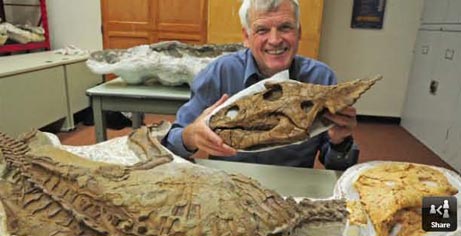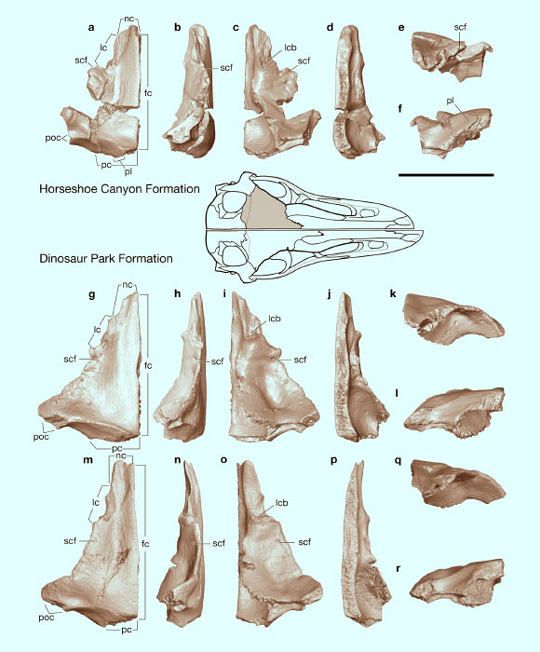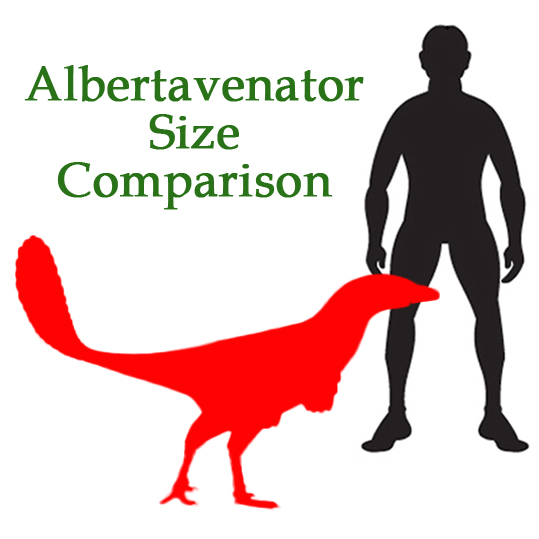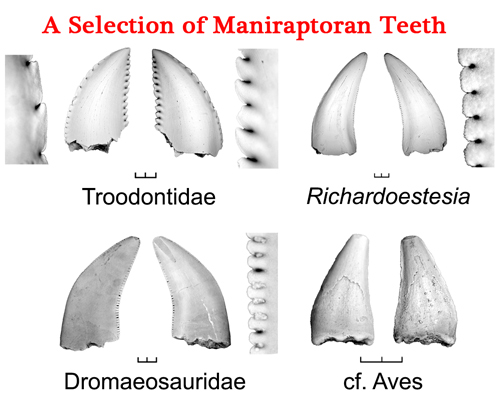Albertavenator – Something to Get Your Teeth Into
Albertavenator curriei – Implications for the North American Troodontids
World-famous Canadian palaeontologist Phil Currie has been honoured by having a new species of North American troodontid Albertavenator curriei, named after him. Phil Currie has been at the forefront of vertebrate palaeontology for a long time now and it is great to see that his fellow scientists have honoured his contribution to the science in this way. However, whilst other media outlets have focused on this accolade, in this article, we look at the what this means when it comes to identifying other small “raptor-like” dinosaurs from their teeth and fossilised jaws.
An Illustration of the Newly Described Troodontid Albertavenator curriei
Picture credit: Oliver Demuth
“Currie’s Alberta Hunter”
This new dinosaur species has been described from fragmentary skull elements found in the Horseshoe Canyon Formation (Horsethief Member). Albertavenator roamed this part of Canada some 71 million years ago (Early Maastrichtian faunal stage of the Late Cretaceous).
The name translates as “Currie’s Alberta hunter”. Professor Currie has had a number of dinosaurs named after him already, including a member of the tyrannosaur family (Teratophoneus curriei), fossils of which come from Utah. Albertavenator is the second dinosaur from Alberta named in honour of Professor Currie. Epichirostenotes curriei, a bird-like maniraptoran theropod assigned to the Caenagnathidae family, fossils of which also come from the Horseshoe Canyon Formation, carries his name.
Palaeontologist Phil Currie
Phil Currie has made a tremendous contribution, not only to the Royal Tyrrell Museum at Drumheller, but also to the recently opened (September 2015), Philip J. Currie Museum located to the west of the town of Grande Prairie (Alberta). In a career spanning five decades, Professor Currie has established himself as one of the world’s most-respected dinosaur experts. He has won numerous awards, including in 2012, the prestigious Explorers Medal.
To read more about this award: Phil Currie is Honoured by the Explorers Club.
Award-winning and Highly Respected Palaeontologist Phil Currie
Picture credit: Bruce Edwards (from a video interview)
Albertavenator curriei
Researchers thought that the fossil bones belonged to a species of Troodon, fossils assigned to this genus have been found all over North America from the Dinosaur Provincial Park and Judith River Formations to Alaska, New Mexico and as far south as Texas. Analysis of the frontal bones (bones from top of the skull), revealed that this dinosaur was different, its skull was shorter and more robust when compared to numerous Troodon skull specimens.
The difference in the shape of the bones was not put down to different growth stages or deformation of the bones during fossilisation, there were enough distinguishing features to establish a new dinosaur genus.
Comparing the Skull Bones of A. curriei and Troodon inequalis
Picture credit: Canadian Journal of Earth Sciences (Evans et al)
The picture above shows the skull bones (frontals) of Albertavenator curriei from the Horseshoe Canyon Formation (top) compared to comparable material assigned to Troodon inequalis from the Dinosaur Provincial Park Formation (bottom). Abbreviations: fc – frontal midline contact, lc – lacrimal contact with frontal, lcb – lacrimal buttress, lsc – laterosphenoid contact with frontal, nc – nasal contact with frontal, or – orbital rim, pc – parietal contact with frontal, pl – parietal lappet, poc – postorbital contact with frontal, scf – supraciliary foramen.
Note: the scale bar = 1 cm.
Delicate Bones of Albertavenator curriei
Lead author of the scientific paper, published in the Canadian Journal of Earth Sciences, Dr David Evans (Royal Ontario Museum), stated:
“The delicate bones of these small, feathered dinosaurs are very rare. We were lucky to have a critical piece of the skull that allowed us to distinguish Albertavenator as a new species. We hope to find a more complete skeleton of Albertavenator in the future, as this would tell us so much more about this fascinating animal.”
Albertavenator is estimated to have weighed about sixty kilogrammes and measured around two metres in length.
A Scale Drawing of Albertavenator (A. curriei)
Picture credit: Everything Dinosaur
To view articulated models of dromaeosaurs and other dinosaurs: Beasts of the Mesozoic Figures.
Rare Troodontid Fossil Material – What About the Teeth?
Much of the fossil material used to describe this new species was found in the early 1990s. The naming of Albertavenator is yet another example of a new genus being erected from further study of dinosaur fossils within a museum’s collection, in this case the Royal Tyrrell Museum. Substantial troodontid body fossils are rare from strata that are dated to the Maastrichtian faunal stage of the Cretaceous, the exception to this are the copious amounts of teeth that have been assigned to this genus.
The researchers note that jawbone shape and the teeth associated with a relatively complete dentary (lower jaw), from the Horseshoe Canyon cannot be distinguished from lower jaws and teeth found in the Dinosaur Park Formation. If the dentary and teeth from the Horsethief Member of the Horseshoe Canyon Formation prove to belong to A. curriei, then isolated teeth and jaws are no longer able to be allocated to one, specific dinosaur genus – Troodon. If the teeth and jaws of a dinosaur like Albertavenator cannot be distinguished from the teeth and jaws of Troodon, then these fossils are unusable for identifying dinosaur genera.
Identifying Dinosaur Genera
Co-author of the study, Derek Larson (Assistant Curator of the Philip J. Currie Dinosaur Museum), explained:
“This discovery really highlights the importance of finding and examining skeletal material from these rare dinosaurs.”
Typical Maniraptoran Teeth
Picture credit: Everything Dinosaur
The picture above shows a selection of different dinosaur teeth, troodontid teeth can be identified by their over-sized serrations (large denticles). However, the identification of a new species of troodontid in the Late Cretaceous of North America means that isolated teeth cannot be ascribed specifically to the Troodon genus. It is very likely that Albertavenator is just one of a number of small theropods that lived in Canada, the small theropod dinosaur diversity in the latest Cretaceous of North America is likely to have been underestimated.
Skull Bones Assigned to Albertavenator curriei
Picture credit: Canadian Journal of Earth Sciences (Evans et al)
The scientific paper:
“A New Species of Troodontid Theropod (Dinosauria: Maniraptora) from the Horseshoe Canyon Formation (Maastrichtian) of Alberta, Canada.” by D. C. Evans, T. M. Cullen, D. W. Larson, and A. Rego, published in the Canadian Journal of Earth Sciences.
Visit the Everything Dinosaur website: Everything Dinosaur.







